In this post we present published information, in chronological order, on Ouranopithecus macedoniensis, a species belonging to the Hominidae family, dating back to the Late Miocene.
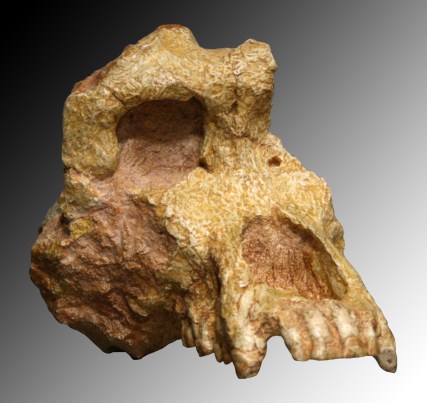
Abstract Miocence hominoid material is very scarce and has previously only been reported as cranial fragments in the Old World. Here we describe a new specimen of Ouranopithecus macedoniensis, which consists of the right part of the face of an adult male with a portion of the frontal bone, a portion of the left part of the face and the maxilla with complete dentition except the right third molar. The characters of this specimen are not congruent with those of Sivapithecus and the pongids, but are more primitive and plesiomorphic for the recent hominid clade (Gorilla, Pan and Homo). The dental characters differ morphologically and metrically from those of the recent great apes and fit better with Australopithecus afarensis. Ouranopithecus now seems the best candidate forerunner of the Plio-pleistocene Homininae (Australopithecus and Homo). This specimen was discovered in September 1989, in the late Miocene deposits of central Macedonia (G.K., L. de B. and C.B.), and prepared by O.K. in Thessaloniki and G. Mouchelin in Poitiers. It comes from the new locality of Xirochori in the red sandstone of the Nea Messimbria formation. The fossil is the property of the University of Thessaloniki, Greece (catalogue number XIR-1).
(Source: “New hominid skull material from the late Miocene of Macedonia in Northern Greece”, by L. de Bonis et al., 1990)
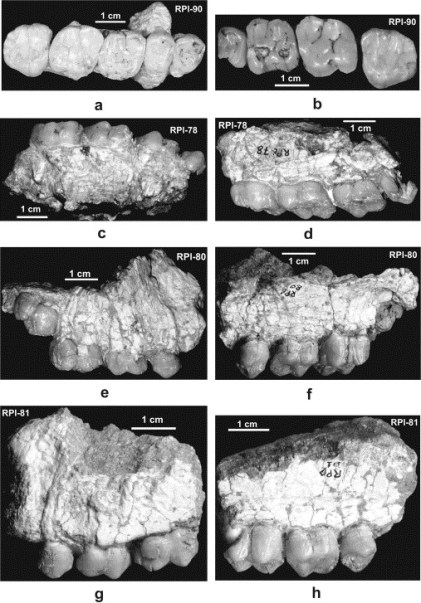
Abstract New specimens (face and mandible) recovered from late Miocene deposits of Macedonia (northern Greece) are described. They have been found in the localities of Xirochori and Ravin de la Pluie and are identified as Ouranopithecus macedoniensis (Hominidae, Hominoidea). These specimens have some derived characters they share with the Plio-Pleistocene Homininae and O. macedoniensis is considered as the sister group of the latter. Some characters could be possibly shared with Kenyapithecus and would indicate that the origins of the sub-family would be older than the late Miocene.
(Source: “The face and the mandible of Ouranopithecus macedoniensis: description of new specimens and comparisons”, by Louis de Bonis & George D. Koufos, 1993)
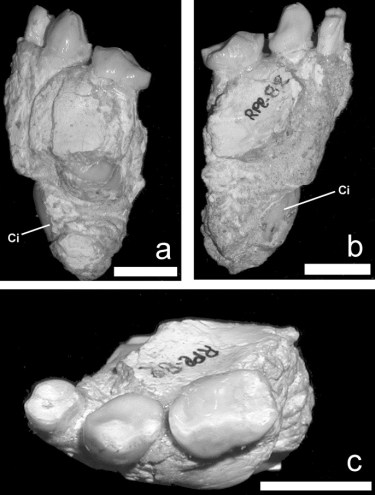
Abstract A maxilla with both toothrows C-M3 of a late Miocene hominoid is described. It was found at the locality Nikiti 1 (NKT) of Chalkidiki (Macedonia, Greece). The locality has been dated to late Vallesian-earliest Turolian. The morphological characters and the comparison of the new maxilla suggest that it is a female individual of Ouranopithecus macedoniensis. It is the first known female maxilla of the species. Comparison with the other two known male maxillae of Ouranopithecus macedoniensis indicates the following differences: smaller size of maxilla and teeth, smaller mesial groove in the canine, more lingually situated mesial groove in the canine, slightly smaller mesiobuccal projection in P3 and relatively shorter P4. There are no significant morphological differences in the molars. Various statistical parameters for the Ouranopithecus teeth have been calculated and compared with those of the extant hominoids. This comparison suggests the presence of a single species in the sample.
(Source: “The first female maxilla of the hominoid Ouranopithecus macedoniensis from the late Miocene of Macedonia, Greece”, by George D. Koufos, 1995)

Abstract Two mandibular fragments with associated milk teeth assigned to the late Miocene hominoid primate Ouranopithecus macedoniensis are analyzed. The fossils, which belong to a single individual, were found in the Vallesian locality of “Ravin de la Pluie” of the Axios Valley (Macedonia, Greece). The material is described here and compared with extant and extinct hominoids, allowing assessment of the evolutionary trends in the deciduous lower dentition within the Hominoidea. Hylobatids represent the more primitive pattern. Gorilla is slightly more derived than hylobatids, but less derived than Pongo and Pan, the latter being the most derived. With relatively smaller deciduous canines and more molarized deciduous premolars, Ouranopithecus is more derived than both Pan and Gorilla. Among the fossil hominoids, Proconsul, representing the primitive condition, has a very simple dp(3)and a dp(4) that has a trigonid that is taller than the talonid and which lacks a hypoconulid. Griphopithecus is more derived than Proconsul in having a dp(4) with a lower trigonid, a hypoconulid, and a less oblique cristid obliqua. Australopithecus and Paranthropus possess a similar morphology to that of Homo, while Ardipithecus appears to be more primitive than the latter genera. Ouranopithecus has a more derived lower milk dentition than Proconsul and Griphopithecus, but less derived than Australopithecus and Paranthropus. The comparison of the lower milk dentition of Ouranopithecus confirms our previous conclusions suggesting that this fossil hominoid shares derived characters with Australopithecus and Homo.
(Source: “The deciduous lower dentition of Ouranopithecus macedoniensis (Primates, Hominoidea) from the late Miocene deposits of Macedonia, Greece”, by Koufos GD, de Bonis L., 2004)
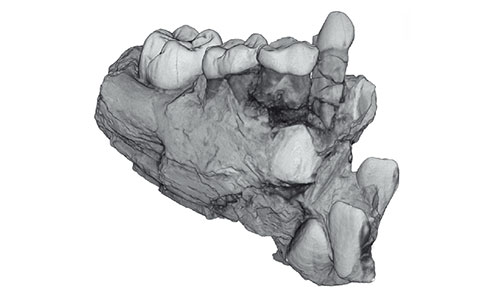
Abstract Two Late Miocene hominoids are known from Greece. The first, Graecopithecus freybergi, is known by a single mandible with the worn m2 from the locality of Pyrgos Vassilissis, near Athens. The other, Ouranopithecus macedoniensis, is known from Axios Valley and Chalkidiki (Macedonia, Greece) by a partial skull and a set of maxillary and mandibular remains. Some authors consider these two hominoids as synonyms and in the present article a detailed comparison of them is given. The morphology and size of the symphysis, the more robust mandible, the more open dental arcade of Ouranopithecus distinguishes it clearly from Graecopithecus. Moreover, the incompleteness of the mandible of Graecopithecus with the doubtful morphology and size, the limited material and the uncertain geological age of the locality cannot allow precise and clear comparisons with the rest extant and extinct hominoids. Thus in our opinion there are not enough data to support the similarity, and therefore, the synonymy of the two genera. The Pyrgos mandible must remain as a separate and isolated genus with one species, which only includes this sole mandible.
(Source: “The Late Miocene hominoids Ouranopithecus and Graecopithecus. Implications about their relationships and taxonomy”, by George D. Koufos & Louis de Bonis, 2005)

Abstract During the last five years our continued excavations in the known late Miocene mammal localities of Macedonia (Greece) provided severalnew specimens of the hominoid primate Ouranopithecus macedoniensis. This new material includes maxillary and mandibular remains and it isdescribed and compared to the old material of Ouranopithecus in the present article. The material of Ouranopithecus from the three knownlocalities “Ravin de la Pluie”(RPl), “Xirochori 1”(XIR) and “Nikiti 1”(NKT) includes a complete series of tooth rows representing all wearingstages. Thus, the study of the dental wear of Ouranopithecus upper and lower teeth is studied and compared to that of the recent hominoids Gorilla and Pan, as well as to Australopithecus afarensis. The latter species is well known by a series of tooth rows of different wearing stages. The canine’s attrition of Ouranopithecus has a more derived pattern than that of the recent hominoids (Gorilla and Pan) and less derived than A.afarensis. The p3 of Ouranopithecus has similar attrition to that of A. afarensis, the attrition of the molars in Ouranopithecus, A. afarensis andPan follows a similar pattern, while in Gorilla it is different.
(Source: “New material of Ouranopithecus macedoniensis from late Miocene of Macedonia (Greece) and study of its dental attrition”, by George D. Koufos & Louis de Bonis, 2006)
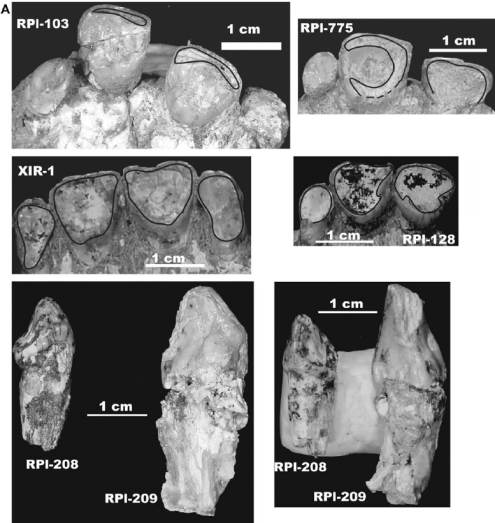
Abstract Dental enamel thickness is commonly listed among the diagnostic features for taxonomic assessment and phylogenetic reconstruction in the study of fossil hominids, and is widely used as an indicator of dietary habits and palaeoenvironmental conditions. However, little quantitative information is currently available on its topographic variation in deciduous crowns of fossil primates. By means of high-resolution microtomography, we investigated the inner structural morphology of the mixed lower dentition of Ouranopithecus macedoniensis, a late Miocene large-bodied ape from Macedonia, Greece. With respect to the extant African apes and Homo, O. macedoniensis shows a significant diff erence in occlusal enamel thickness between the relatively thin deciduous second molar and the absolutely thick-enamelled permanent first molar
(Source: “Ouranopithecus macedoniensis (Mammalia, Primates, Hominoidea): virtual reconstruction and 3D analysis of a juvenile mandibular dentition (RPl-82 and RPl-83)”, by Roberto Macchiarelli et al., 2009)

Abstract Two well preserved phalanges, one proximal and one intermediate, are identified and described. They constitute the first postcrania ever described of Ouranopithecus macedoniensis (Primates, Hominoidea) from the late Miocene locality of Ravin de la Pluie (RPl), Macedonia (Greece). They are isolated specimens, and the only ones known for their genus. The hypotheses that these specimens derive either from the hand or from the foot were tested. Comparisons with living apes of known positional behaviour were made to assess the functional signal in these specimens. The proximal phalanx, either manual or pedal, closely matches the proximal phalanges of terrestrial quadrupedal primates or the bipedal primate Homo. With respect to the intermediate phalanx we show that it closely matches phalanges of quadrupedal terrestrial primates. The terrestriality of Ouranopithecus, here reconstructed from phalangeal remains, is in agreement with our previous results of dental studies (thick check teeth enamel and microwear pattern of incisors and molars), which indicate that it was a hard object feeder living near the ground.
(Source: “First discovery of postcranial bones of Ouranopithecus macedoniensis (Primates, Hominoidea) from the late Miocene of Macedonia (Greece)”, by George D. Koufos & Louis de Bonis, 2014)

Abstract New hominoid teeth from the late Miocene locality Ravin de la Pluie (RPl) of the Axios Valley (Macedonia, Greece) are studied in this article. Their morphology, dimensions and proportions are similar to the hominoid Ouranopithecus macedoniensis, allowing their attribution to this taxon. The studied material provides some new morphological characters for the female P3 (small asymmetry, small mesiobuccal crown projection, paracone higher than protocone) and the lower canine (mesial groove: large in the male and small in the female, distobuccal fovea: large in the female and small in the male). The new material enriches the collection of O. macedoniensis. The estimated degree of sexual dimorphism of the RPl O. macedoniensis, calculated by the multivariate size dimorphism method, is compared with those of extant hominoids (Gorilla, Pan, Pongo) and of the late Miocene Lufengpithecus lufengensis from China, which is considered as more dimorphic than any living hominoid. The results suggest that Ouranopithecus multivariate size dimorphism for the premolar, molar and post-canine row is similar to those of Pongo and Lufengpithecus, slightly higher than that of Gorilla and clearly higher than that of Pan. Therefore, O. macedoniensis is apparently one of the most sexually dimorphic hominoids and the RPl assemblage is monospecific.
(Source: “New Material of the Hominoid Ouranopithecus macedoniensis from the Late Miocene of the Axios Valley (Macedonia, Greece) with Some Remarks on Its Sexual Dimorphism”, by George D. Koufos et al., 2016)
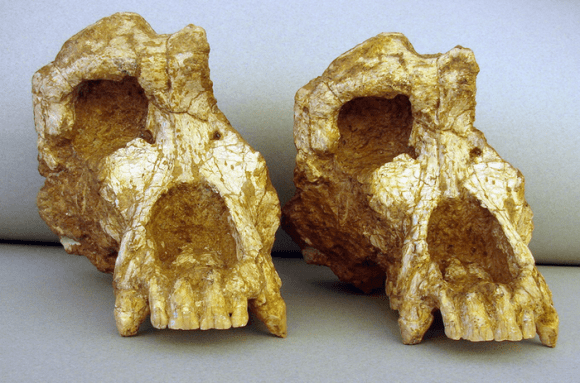
Abstract The genus Ouranopithecus has been documented since 1974 in the late Miocene deposits of Northern Greece in the form of several mandibles, a number of teeth and an almost complete face (XIR-1) of Ouranopithecus macedoniensis. The specimen XIR-1 belongs to an adult male individual and was discovered in 1989 in the locality Xirochori 1 (XIR), in association with mammal fauna (de Bonis and Koufos, 1993). The facial area of the XIR-1 is well preserved, but slightly distorted as a result of taphonomic processes. The right side of the lower face is complete, and a big portion of the frontal bone as well as part of the left side of the face is preserved. The magnetostratigraphic study of the Xirochori section suggested an estimated age of ~ 9.6 Ma (late Vallesian,) for the fauna (Koufos et al., 2016). Genetic studies utilizing methods of ‘Molecular Clocks’ (Yoder and Yang, 2000), based on protein-coding regions of mtDNA, suggest that the split between humans and African apes is between 5-10 Ma. Since the age of Ouranopithecus macedoniensis is close to the divergence of hominoids and African apes, its phylogenetic position relative to known hominids is of great importance.
The aim of this study is, first, to virtually restore symmetry to the deformed face of Ouranopithecus macedoniensis (XIR-1) and to reconstruct its facial anatomy using mirror imaging, a virtual anthropology technique. The most important advantage of such methods, relative to traditional reconstruction techniques, is that they allow digital manipulation of the objects and therefore are not destructive or damaging the precious fossil specimens (Benazzi et al., 2010). Our second aim is to analyze the facial morphology of the virtual reconstruction using 3D geometric morphometrics and to explore shape variation between O. macedoniensis and a comparative sample of other fossil hominoids and extant great apes.
High-resolution computed tomography (CT) was used to create a digital representation of the XIR-1 specimen. A virtual reconstruction of the facial area of XIR-1 was achieved by using a mirror image of the better-preserved side, so as to restore bilateral symmetry. Additionally, a set of anatomical landmarks (51), representing standard osteometric points, were registered on the virtual reconstruction of XIR-1. The same landmarks were collected from adult crania of Homo sapiens, Gorilla gorilla, Pan troglodytes, Pongo pygmaeus and fossil hominoids, including the Eurasian Pierolapithecus catalaunicus, Dryopithecus, Rudapithecus hungaricus and the African Proconsul, as well as the hominins Sahelanthropus tchadensis, and Australopithecus africanus.
Preliminary results indicate that Ouranopithecus is more similar to Gorilla than to Homo, Pan or Pongo, and support the hypothesis that the overall shape of the face of O. macedoniensis is similar to Gorilla and other Eurasian dryopithecines (Pierolapithecus catalaunicus, and Dryopithecus).
(Source: “A new three dimensional analysis of the Ouranopithecus macedoniensis cranium (Late Miocene, Central Macedonia, Greece)”, by Melania Ioannidou et al., 2016)

Abstract The upper incisor lingual morphology of the late Miocene Greek hominoid Ouranopithecus macedoniensis was almost unknown, as the described earlier maxillary remains preserve only worn incisors. During the most recent excavations in the type locality of Ouranopithecus, Ravin de la Pluie (RPl) of Axios Valley (Macedonia, Greece), four little-worn upper central incisors were recovered. This material and a few additional worn upper incisors, discovered recently, are described and compared in this article. Even though a morphological comparison with the old RPl material, lacking unworn or little worn incisors, is impossible, the metrical comparison and the monospecfic character of the RPl hominoid sample suggest that the described incisors can be assigned to Ouranopithecus macedoniensis. The described upper central incisors are separated in two size-groups which in general have similar morphology except for some minor differences such as the presence of a pronounced mesial lingual pillar in the small-sized specimens. The observed significant size difference among the studied incisors is attributed to the strong sexual dimorphism of Ouranopithecus, which is also well expressed in the other teeth. The lingual morphology of the upper incisors of Ouranopithecus are not identical to those of extant great apes, though they have some similarities with those of the African great apes (Gorilla and Pan), while they are clearly different from those of the Asian great ape (Pongo). Even though they have some morphological similarities, the O. macedoniensis central incisors are probably not identical to those of the Eurasian Miocene hominoids; the most similar central incisor is that of Ouranopithecus turkae. Among the known African Miocene hominoids, Nakalipithecus upper central incisor is quite similar in morphology and size to that of Ouranopithecus.
(Source: “Upper incisor morphology of the Late Miocene hominoid Ouranopithecus macedoniensis from Axios Valley (Macedonia, Greece)”, by George D. Koufos & Louis de Bonis, 2017)
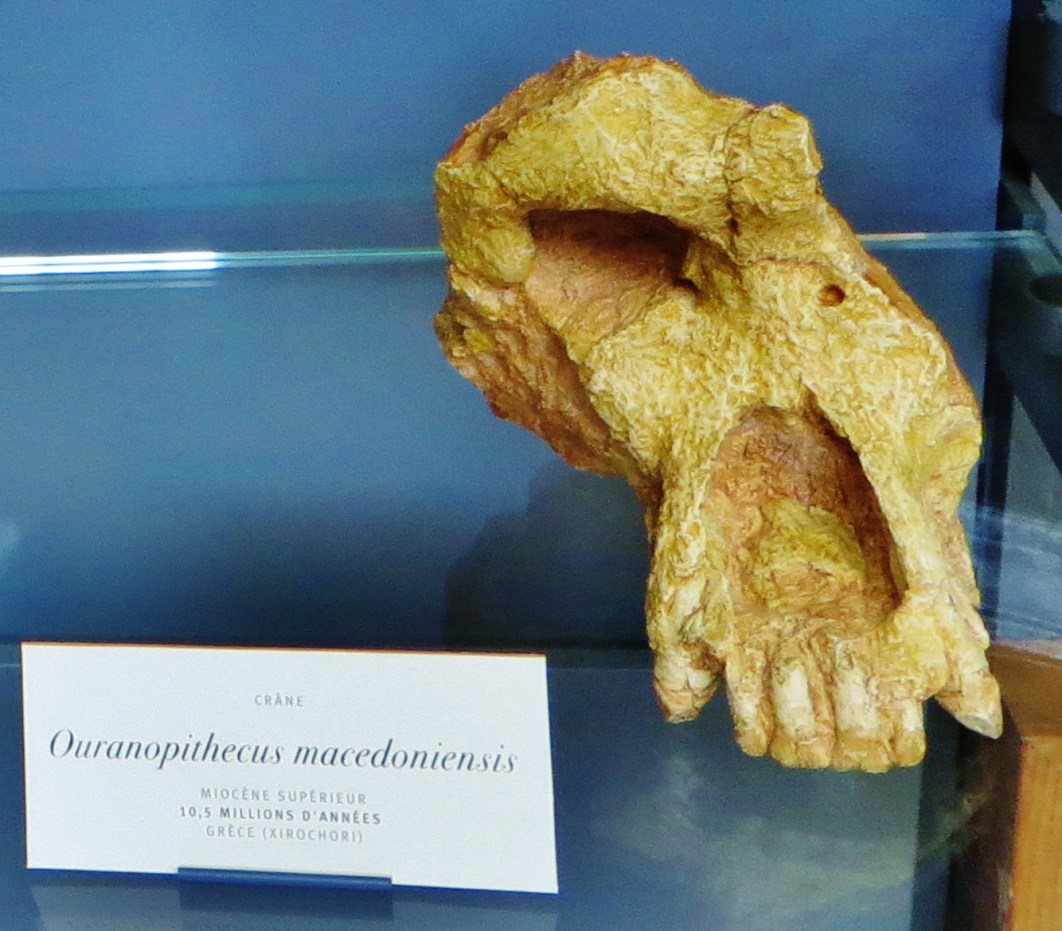
Research-Selection for NovoScriptorium: Maximus E. Niles

Reblogged this on ilcantooscuro.
LikeLike